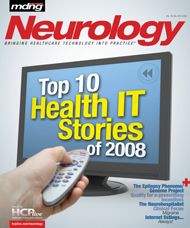Publication
Article
MDNG Neurology
5 Questions… with A Neurohospitalist
Andy Josephson, MD, is an assistant professor of neurology at the University of California, San Francisco, where he directs the Neurohospitalist Program.
1. Why has the specialty of neurohospitalist emerged?
I think there are a variety of reasons that involve pressure in both the inpatient and the outpatient worlds. In the inpatient setting, there is a lot of pressure regarding complexity of care. Neurology has turned into a specialty focus on the acute management of emergencies from stroke to status epilepticus. As new treatments develop, many of which are time-based, there’s pressure for neurologists to be available 24 hours a day, seven days a week in the hospital to oversee and administer these acute therapies, making it very difficult for one to care for patients as mainly an office-based physician who comes to the hospital a couple of times a day to see patients. Additionally, pressure from CMS and other payers to be increasingly concerned about markers of safety and quality care, as well as pay-for-performance, make it so that an inpatient neurologist has a much larger job than in the past. Similarly, the outpatient practice has a lot of pressure to see more patients and spend more time with them. It’s very difficult for someone to do both outpatient and inpatient neurology at the same time, especially with the emergence of a group of physicians who mainly practice in the inpatient world now caring for neurological patients.
It depends. I think that many outpatient neurologists will be happy to have colleagues who mainly manage the inpatient service, at least while they’re busy seeing outpatients. You can imagine a scenario in which a group of physicians—mainly outpatient physicians—decide each month that one of them will be the inpatient physician. It may be that outpatient physicians still spend time in inpatient neurology, but for those who don’t, many will find it refreshing that they can concentrate on outpatient neurology and will not be faced with the stress of having to squeeze in calls from the emergency department and trips over to the hospital multiple times a day.
3. Are office-based neurologists becoming neurohospitalists?
I get a fair number of calls and e-mails each week from neurologists— some office-based, some academicbased— who are interested in the field and are excited about this idea. Just like in any sub-specialty, there are many different things that one can do if they’re a neurologist, and becoming a neurohospitalist is one of these. Many neurologists are excited about the idea of taking care of inpatients, which is what they enjoy and would like to dedicate more, if not all, of their time toward. It’s something that I think has gotten people very excited as a career possibility.
4. How important is technology for neurohospitalists?
I think it’s especially important for neurohospitalists for a couple of reasons: because some acute emergencies, such as stroke, require a neurologist to review radiology films and get access to the films 24 hours a day, using technology is very important. Second, it really allows the communication between inpatient and outpatient neurologists to go seamlessly. If a patient shows up in the emergency department and has been treated by an outpatient neurologist with an EMR, the inpatient neurohospitalist will know all of the information about the patient’s previous care and diagnoses to be able to provide continuity of care. It also works in a reverse direction. When the patient is discharged from the hospital after being cared for by an inpatient neurohospitalist, the outpatient neurologist has an easy way to determine what was done for the patient during their inpatient stay. Finally, there might be two or three hospitals in a county or a regional area being covered by a single neurohospitalist; remote technology and electronic information allows for this kind of coverage.
5. Will this field expand to all specialties?
Maybe; the pressure is certainly universal across specialties, and there are examples in literature and at my institution of surgical hospitalists, pediatric hospitalists, and psychiatry hospitalists. It seems to be a natural progression. In some cases, the fields are going to be large enough that there’s enough inpatient business allowing somebody to just do inpatient hospitalist medicine, much as the case with internal medicine. In other fields, where the inpatient numbers are relatively small, someone would spend part of his or her time as an inpatient specialist and another part as an outpatient specialist. If the internal medicine model is anything to learn from, this is a model that leads to better patient satisfaction, better physician satisfaction, and potentially better patient outcomes, which is what we’re all ultimately striving to achieve.






